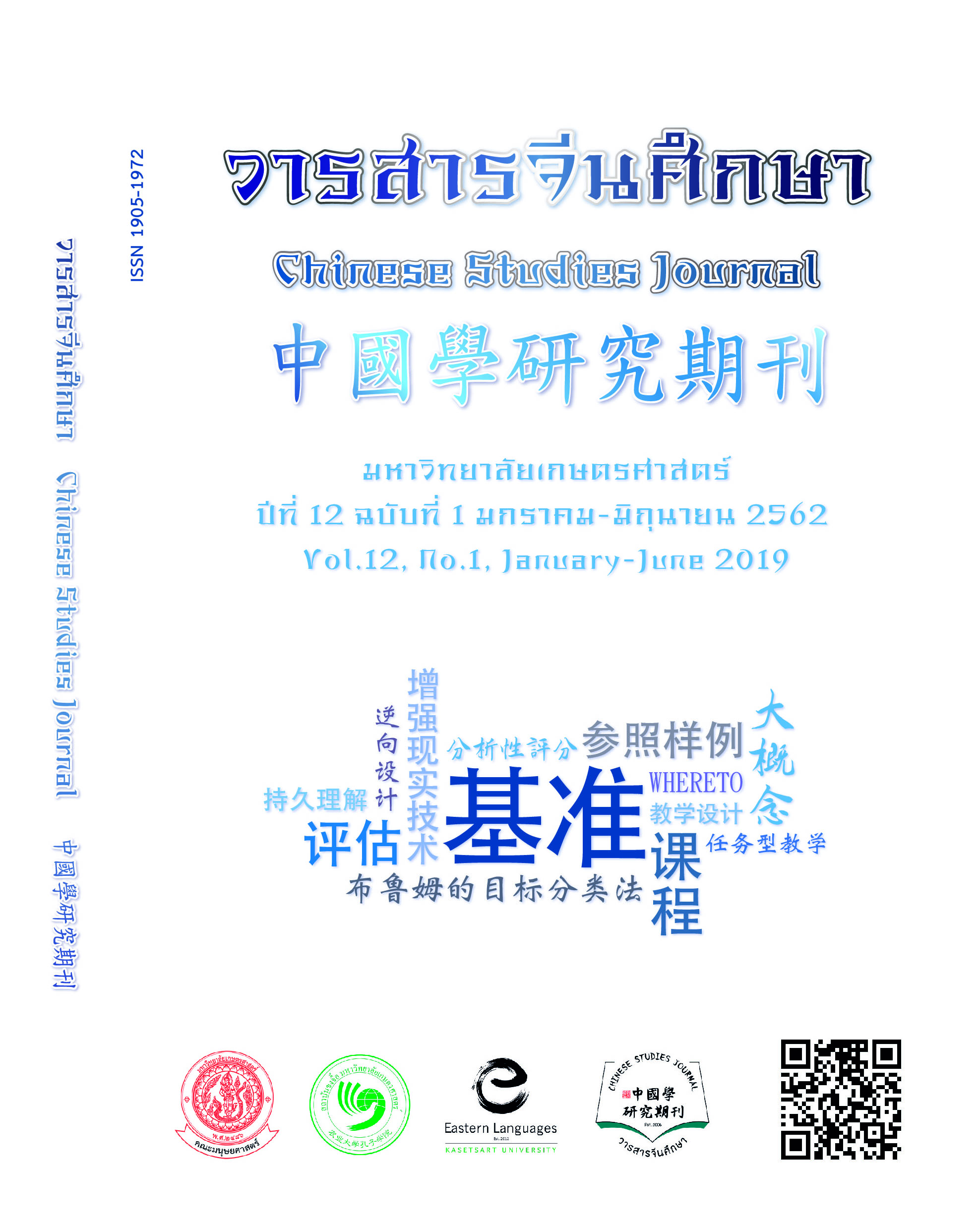Semantic Categorization of Tai Lue Native Vegetable Names
Main Article Content
Abstract
This study focuses on the semantic components of native vegetable names in Tai Lue by adopting two concepts in the cognitive semantic approach, namely meaning and category, for the analysis. The data were collected from 10 Tai Lue people in Xishuangbanna, Yunnan Province of the People’s Republic of China through observation, interview and questionnaires.
The results have revealed that 56 names of Tai Lue native vegetables. Based on the componential analysis, the meanings of the names were found in only seven dimensions of contrast, including [color], [size], [shape], [taste] [race] [location] and [specific characteristic]. Apart from the meaning, these names were also categorized into three levels; generic names, subcategories and specific names as others ethnic languages in the Tai language family.
In conclusion, the present study has shown the world view of Tai lue people about vegetable as food. It can also be inferred the semantic categorization of Tai Lue native vegetable names in Yunnan is simple because most of them are generic names. Moreover, the economic and social change may have caused many Tai Lue people not to know the names of their native vegetables, but also gradually not to consume them.
Article Details
ผลงานทางวิชาการที่ลงตีพิมพ์ในวารสารจีนศึกษา มหาวิทยาลัยเกษตรศาสตร์ เป็นลิขสิทธิ์ของผู้เขียนหรือผู้แปลผลงานนั้น หากนำลงในวารสารจีนศึกษาเป็นครั้งแรก เจ้าของผลงานสามารถนำไปตีพิมพ์ซ้ำในวารสารหรือหนังสืออื่นได้โดยมิต้องแจ้งให้ทราบล่วงหน้า แต่หากผลงานที่ได้รับพิจารณานำลงในวารสารจีนศึกษา เป็นผลงานที่เคยตีพิมพ์ที่อื่นมาก่อนเจ้าของผลงานต้องจัดการเรื่องปัญหาลิขสิทธิ์กับแหล่งพิมพ์แรกเอง หากเกิดปัญหาทางกฎหมาย ถือว่าไม่อยู่ในความรับผิดชอบของวารสารจีนศึกษา มหาวิทยาลัยเกษตรศาสตร์ ทั้งนี้ ความคิดเห็นต่างๆ ในบทความเป็นความคิดเห็นส่วนตัวของผู้เขียน ไม่เกี่ยวกับกองบรรณาธิการวารสารจีนศึกษา มหาวิทยาลัยเกษตรศาสตร์
References
เผยแพร่ความรู้ทางวิชาการและงานวิจัย ปีที่ 19. ฉ.1 น.99 -113.
รัตนา จันทร์เทาว์และเชิดชัย อุดมพันธ์. (2560) . ชื่ออาหารท้องถิ่นอีสานและภาคใต้: มุมมอง
ด้านอรรถศาสตร์ ชาติพันธุ์. วารสารศิลปศาสตร์ มหาวิทยาลัยสงขลานครินทร์ วิทยา
เขตหาดใหญ่ 9, 1 (มกราคม – มิถุนายน 2560) 63-89.
ราชบัณฑิตยสถาน. 2553. พจนานุกรมศัพท์ภาษาศาสตร์ (ภาษาศาสตร์ประยุกต์) ฉบับ
ราชบัณฑิตยสถาน. กรงเทพฯ: ราชบัณฑิตยสถาน.
อนัตตยา คอมิธิน. (2548). การศึกษาการตั้งชื่ออาหารในภาษาไทยตามแนวทฤษฎี
อรรถศาสตร์ปริชาน. วิทยานิพธ์หลักสูตรศิลปศาสตรมหาบัณฑิต สาขาวิชา
ภาษาศาสตร์ มหาวิทยาลัยธรรมศาสตร์.
อุมาภรณ์ สังขมาน. (2552). “การศึกษาทางความหมายและการจัดประเภทของ “ผัก” และ
“ผลไม้” ในการประชุมวิชาการระดับชาติ เรื่อง ภาษาไทยมาตรฐาน ภาษาไทยถิ่น และ
ภาษาย่อยสังคมของไทย: ประเด็นปัญหาและข้นค้นพบใหม่, 15 มีนาคม 2552,
เชียงราย ราชอาณาจักรไทย.
______. (2554). “การตั้งชื่อภาษาไทยของผักพื้นบ้านในจังหวัดสระบุรี”. มนุษยศาสตร์ใน
ทศวรรษ ใหม่: พลวัตแห่งองค์ความรู้กับพหุลักษณ์ทางวัฒนธรรม. กรุงเทพ: แซท โฟร์
พริ้นติ้งจำกัด.
Boas, F. (1964a). “Linguistics and Ethnology.” in D. Hymes. (ed.) Language in
Culture and Society: A Reader in Linguistics and Anthropology. UK:
Harper and Row, Ltd., 15-26.
______. (1964b). “On Geographical Names of the Kwakiutl Indians.” in D.
Hymes. (ed.) Language in Culture and Society: A Reader ikiutl n
Linguistics and Anthropology. UK: Harper and Row, Ltd., 171-182.
Evans, V. and M. Green. (2006). Cognitive Linguistics: An introduction. Edinburgh
University Press: British.
Dong, F. (1984). “Xishuangbanna today”. China’s Minority Nationalities. Beijing:
China Reconstructs. p. 74-85.
Frake, C. O. (1962). “The ethnographic study of cognitive systems.” Reprinted
in Language and Cultural Description, Essays by Charles O. Frake.
Selected by Anwar S. Dil. Standford : Standford University Press.
Kumtanode, S. (2006). Thai Regional Cooking Terms: an ethnosematnic study.
The degree of doctor of philosophy (Linguistics), Mahidol University.
Majid, A. (2012). “A Guide Stimulus-based Elicitation for Semantic Categories”
In The Oxford Handbook of Linguistic work. Thieberger, N., ed., UK:
Oxford University Press.
Rosch, E. (2009). “Categorization” in Cognition and Pragmatics. Dominiek
Sandra, Jan-Ola Ostman and Jef Verschueren, ed., John Benjamin
Publishing: USA.
Schliesinger, J. (2000). Ethnic Groups of Thailand Non-Tai-Speaking Peoples.
Bangkok: Thailand.
Taylor, J. R. 1995. Linguistic categorization: Prototypes in linguistic theory. 2nd
edition. Oxford: Clarendon Press.
Umaporn Sungkaman. (2009). “The semantic categorization of Mon and Thai
native vegetable names” presentation in The Forth International
Conference on Austroasiatic Linguistics (ICCL 4) 29-30 October 2009,
Mahidol University, Nakornpathom, Thailand.
Ungerer, F. and H. J. Schmid. (1996). An Introduction to Cognitive Linguistics.
London and New York: Longman.
Yule, G. (2006). The Study of Language. 3rd ed. Cambridge: Cambridge
University Press.


